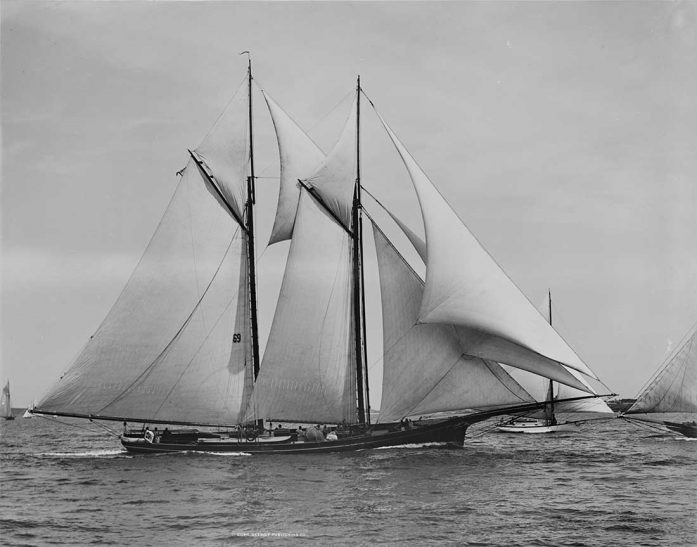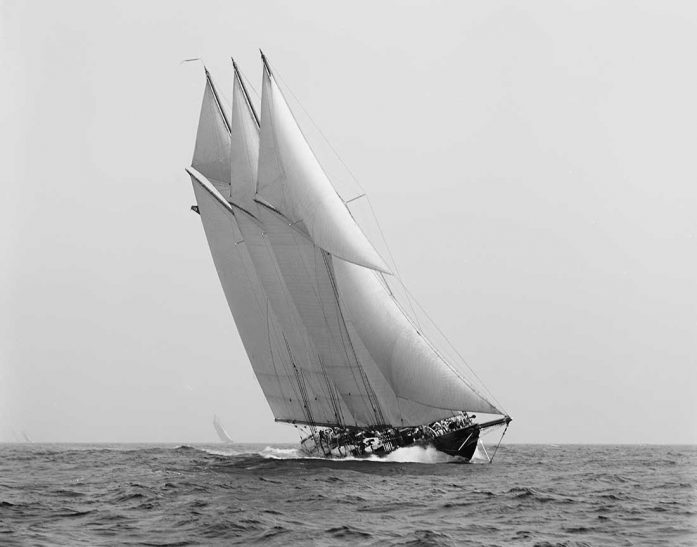The schooner is a type of sailing vessel having a foremast and mainmast, with or without other masts, and having fore-and-aft sails on all lower masts. While the schooner was originally gaff-rigged, modern schooners typically carry a Bermuda rig.

A typical schooner
[source: pinterest]
The Bermuda rig consists of a triangular sail set aft of the mast with its head raised to the top of the mast; its luff runs down the mast and is normally attached to it for its entire length; its tack is attached at the base of the mast; its foot (in modern versions of the rig) controlled by a boom; and its clew attached to the aft end of the boom, which is controlled by its sheet.
Necessary Nautical Terms
The top of all sails is called the head, the leading edge is called the luff, the trailing edge is the leech, and the bottom edge is the foot. The corner where the leech and the foot connect is called the clew. The corner on a fore-and-aft sail where the luff and foot connect is called the tack.
Schooner – Short History
Schooners first evolved in the late 17th century from a variety of small two-masted gaff-rigged vessels used in the coast and estuaries of the Netherlands. They were further developed in North America from the early 18th century, and came into extensive use in New England. The most common type, with two masts, were popular in trades requiring speed and windward ability, such as slaving, privateering, blockade running, and offshore fishing.
More descriptive stuff from Wikipedia
Sailing vessels with a single mast will typically be sloops or cutters, either with a Bermuda or gaff mainsail. There is little economic justification for the cost and complexity of a second mast unless the vessel is reasonably large, say above 50 feet (15 m) LOA.

The Atlantic, a famous boat of this kind
[source: wikipedia]
If a vessel’s size requires a second mast, the sail plan will usually be a schooner, ketch or yawl, all of which are fore-and-aft rigged, although the “topsail schooner” variant carries one or more square topsails on its foremast. The two-topsail schooner variant carries square topsails on both the mainmast and the foremast. The schooner may be distinguished from both the yawl and the ketch by the disposition of its masts, and thus the placement of the mainsail. On the yawl and ketch, the mainsail is flown from the forward mast, or mainmast, and the aft mast is the mizzen-mast. A two-masted schooner has the mainsail on the aft mast, and its other mast is the foremast. Compared to a single-masted vessel, all the two-masted vessels can have a lower center of pressure in the sail plan.
Although the ketch and, to a much lesser extent, the yawl are more popular than the schooner in Europe, the schooner is arguably more efficient. The schooner can carry a larger sail area, because of its much larger mainsail and the effective sail(s) between the masts. Also, in a schooner, all the sails work together in a complementary fashion, optimizing airflow and drive. By contrast, on a ketch, or especially a yawl, the mizzen sail provides proportionately less power, being smaller than, and frequently blanketed by, the mainsail. The ketch however offers advantages in sail handling in poor weather.
I’m sorry I had to use a lot of info from Wikipedia, but this time it was properly explained, so I agreed with it.
If you like what you read, please subscribe to this blog by completing the form. If you want to help more, start by following us on Twitter, and like our page on Facebook. You don’t know what good things may happen. To lighten your day, check our pins on Pinterest, we can be friends there too. Oh, and if you need a really good looking blog attached to your site, or just for fun, to express your feelings more competitively, read this Own Your Website offer! Thank you very much.
